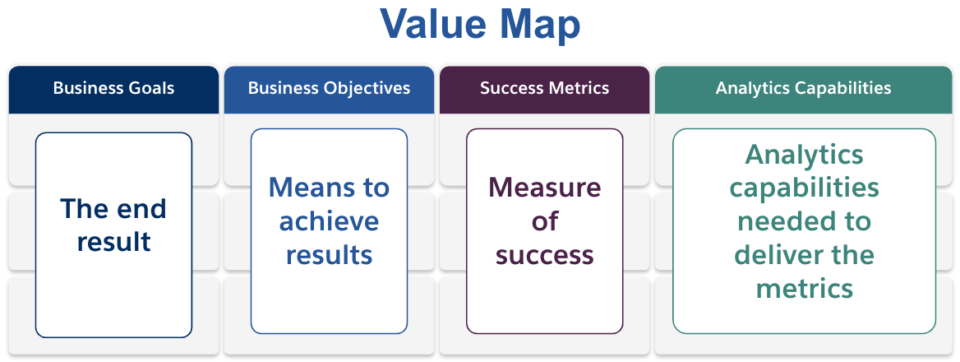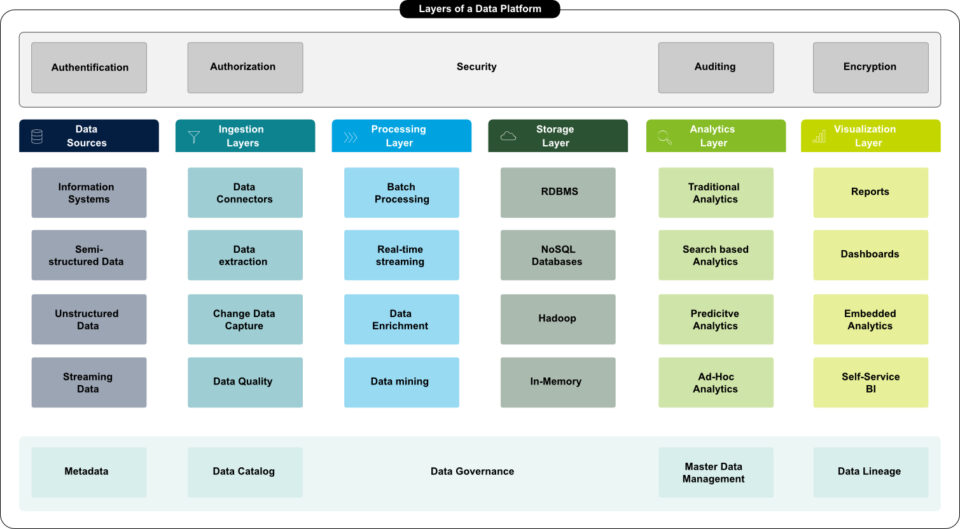A Comprehensive Guide to Harnessing the Power of Data in Today’s World (continued)
Welcome back! In our last post, we discussed why companies should become more data-driven and the essential components of a modern data strategy. Today, we’ll delve into the Analytics Strategy inspired by Tableau Blueprint, a proven approach for successful data and digital transformation projects. By the end of this post, you’ll have a clear action plan to kickstart your own transformation. So, let’s begin!
Analytics Vision
Developing a data analytics strategy goes beyond creating pretty visualizations or dashboards. The key to bridging the gap between analytics investments and business outcomes is setting an analytics vision that aligns with your organization’s goals, key performance indicators, and strategic initiatives. This is where key executives come in. By involving them early on, you can create a joint vision statement that captures the answers to the following questions:
- What are our key strategic business goals?
- What business outcomes are we trying to achieve with our strategic initiatives?
- What metrics and KPIs help us track our progress?
- Who needs access to these metrics and KPIs to make smarter decisions?
- When do decision-makers need to see data to make timely decisions?
Answering these questions will help you create a strong analytics vision that can guide your team, department, or organization towards a lasting data culture.
Business Value
Once you have defined your analytics vision, the next step is to focus on generating business value from your investment in analytics. To do this, you need to create a value map, a consolidated view that details how you measure success and achieve business goals. The value map is a living document that evolves over time, co-created with stakeholders, and includes business goals, objectives, success metrics, and analytics capabilities. This approach ensures that your analytics project prioritizes business value, thereby avoiding wasted resources and boosting confidence in analytics.

Roles & Responsibilities
In a data strategy implementation, you need to consider three categories of people: sponsors, project team members, and consumers. Sponsors provide funding and decision power, the project team executes the project, while consumers benefit from the project outcomes in their day-to-day activities. Therefore, it’s important to understand the roles involved, who fills these roles, and their responsibilities. For more context to each of the categories, refer to the relevant tab of the Tableau Blueprint Planner.
Architecture Survey
Knowing your current and future infrastructure is critical in implementing an analytics project. Therefore, you need to identify technology solutions for the following processes: data integration, storage, transformation, analytics & visualization, governance, and security. Based on your current stage in the analytics journey, some of these solutions might already be in place, while others will require finding and implementing.
Keeping an overview of everything you have and will need is essential to understand the potentials and limitations of becoming a data-driven organization. For a more detailed approach, check out Deloitte’s ‚Layered Architecture for Data Platforms‘.

Data and Analytics Survey
Identifying the data and analytics needs of your organization is an exercise best done by line-of-business leaders for their departments. This survey helps identify key data sources, how data is consumed, and what analytical skills exist or need development among teams. You can find an example survey in the Tableau Blueprint Planner.
Use Cases and Data Sources
After the Data & Analytics Survey, you need to collect information about use cases that can deliver real business value. Begin with those that promise to deliver quick benefits to the business, as this increases adoption and builds trust between developers and business. Here are some initial use case ideas by department (summarised from the Tableau Blueprint documentation):
- IT — Hardware/software asset inventory, helpdesk call volume/resolution time, resource allocation, security patch compliance
- Finance — Budget planning and spend, accounts payable, travel expenses
- Marketing — Campaign engagement, web engagement, leads
- Human Resources — Turnover rate, open headcount, new hire retention, employee satisfaction
- Sales — Sales/quota tracking, pipeline coverage, average deal size, win/loss rate
- Facilities Operations — Physical locations, call center volume/workload distribution, work request volume/resolution time
Data and Content Governance
As with all projects, there comes a time after the project. And it is equally important to ensure that good practices are upheld to maintain a high level of data and content quality. Like in a restaurant business, if the first meal you make for your guests is great, but every meal after is bad, you’ll lose your guests. In the same sense, if the quality of your data and contents is bad, you will lose the ones who are ultimately responsible for deriving value from data, the data consumers.
Data and content governance involve activities and responsibilities in the following areas:
- Data Source Management
- Data Quality
- Enrichment & Preparation
- Data Security
- Metadata Management
- Monitoring & Management
- Content Management
- Authorisation
- Content Validation
- Content Promotion
- Content Certification
- Content Utilization
Checking the questions listed in the Tableau Blueprint can help you design your data and content governance processes.
Talent Development
Talent development is crucial for upskilling workers and improving digital competencies. To assign the right level of training to each role, it is important to differentiate between roles. In an organization, there are typically executive sponsors, consumers, analysts, developers, data scientists, data stewards, community leaders, administrators, and architects.
Popular options for upskilling include e-learning platforms like edx, Coursera, or Udemy, or technology-specific learning offerings developed and offered by software vendors. It is recommended that you create a role-education map where you assign various types of professional development tools to each of the roles.
Community Planning
Community planning is also essential for the success of a data and digital transformation initiative. Building a community of believers and followers of the north star is critical to seeing lasting results. Community building involves activities such as communications, engagements, and support plans to nurture the use of analytics for decision-making. Hosting regular community events to share analytics use cases and success stories can help inspire and engage the community. For more inspiration on this topic, I recommend checking out this 3-mins read here by BrandiBeals – 10 Effective Ways to Engage Your Data Community.
Modern Data Strategy – In a Nutshell
A strong strategy framework with three streams (Agility, Proficiency and Community) helps you, keeping the overview on everything going on and gives you confidence as you progress with implementing your analytics strategy. It is the surrounding fence, protecting your organisation from distraction while it is going through the transformation.
The analytics strategy, discussed in this blog post, serves as an action paper. Working collaboratively on all of its 9 steps, will make sure you and your team have a strong vision to follow and a clear plan to act upon. Executing the plan will ultimately lead your organisation towards becoming truly data-driven.
Now, it’s time to take action. Sit down and use the tools you learned about over the course of the last two blog posts. Craft your modern data and analytics strategy to lead your company to lasting success with data.
PS: It’s always a good idea to learn from big organisations. If you think in the same way, I recommend you spend 10 minutes reading ‘10 Steps to Creating a Data-Driven Culture’ by Harvard Business Review.



